Hello, I’m Michael Zhang. Over the years, I’ve explored mountains and gorges across the globe—from the Andes to the Alps. Yet, back home in China, few places have stirred me as deeply as Tiger Leaping Gorge. Tucked away in the highlands of northwestern Yunnan, this incredible canyon is not only a paradise for hikers, but also a gateway into the rich natural and cultural heritage of the region. In this article, I’ll walk you through how to explore Tiger Leaping Gorge the right way—what to expect, which section to choose, and a few useful tips that can help you connect with the soul of Shangri-La.
Summary
About Tiger Leaping Gorge
Tiger Leaping Gorge is one of the deepest canyons in the world and ranks among China’s top ten most beautiful gorges. It has been designated a National AAAA Tourist Attraction. The southern bank of the gorge is backed by Jade Dragon Snow Mountain, while Haba Snow Mountain rises on the northern side. Due to the tight confinement of the high cliffs on both sides, the Jinsha River narrows to just over 50 meters at its narrowest point—legend has it that a tiger once leapt across here, giving the gorge its name. The canyon features steep V-shaped cliffs and a rugged landscape typical of a youthful river valley.
The climate here varies between temperate and cold-temperate monsoonal zones, with an annual average temperature ranging from 4.7°C to 16.5°C. The scenic area can be divided into three parts: Upper Tiger Leaping Gorge (often referred to simply as the Tiger Leaping Gorge Scenic Area), Middle Tiger Leaping Gorge (while the “Dazed Rock” viewpoint is currently closed, all main trekking routes remain open), and Lower Tiger Leaping Gorge.
The gorge is located about 80 kilometers from the city center of Lijiang and runs along the upper reaches of the Jinsha River. It stretches 17 kilometers in total, with winding paths covering around 25 kilometers. The vertical elevation difference from riverbed to mountaintop exceeds 3,900 meters.
- Address: Hutiaoxia Scenic Area, Shangri-La City, Diqing Tibetan Autonomous Prefecture (Apple Maps/Amap)
- Opening hours: 7:00 AM to 6:00 PM (trekking routes open 24/7)
- Recommended visit time: 1–2 hours for the scenic area; 2 days and 1 night for the trekking route
- Best seasons to visit: April to June and September to October
- Virtual tour: Official VR Tour
- Ticket Price: 45 CNY (trekking routes are free)
- Ticket Purchase: Trip.com Discounts
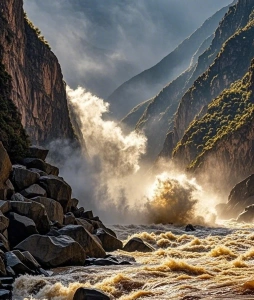
Tiger Leaping Gorge Scenic Map
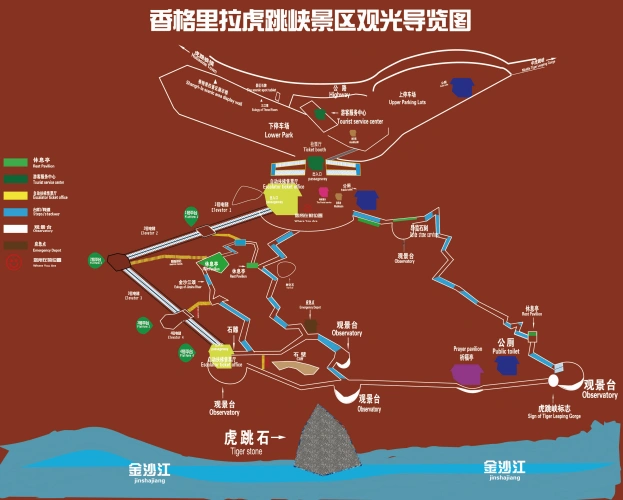
Why You Should Visit Tiger Leaping Gorge
Breathtaking Natural Scenery
With a vertical drop of over 3,900 meters and steep cliffs along the canyon walls, Tiger Leaping Gorge ranks among the deepest gorges on the planet and has drawn backpackers from all over the world. Its dramatic terrain has been featured by international outlets such as National Geographic, Lonely Planet, and the BBC, all of which have praised its stunning vistas. The gorge is divided into three segments—Upper, Middle, and Lower Tiger Leaping Gorge—each offering its own unique charm. At Upper Tiger Leaping Gorge, the Jinsha River crashes into the narrow entryway, producing thunderous waves and breathtaking rapids. Middle Tiger Leaping Gorge is known for its rugged cliffs and dramatic waterfalls, while Lower Tiger Leaping Gorge features more open terrain and comparatively milder rapids.
Rich Cultural Background
Tiger Leaping Gorge is not just a natural wonder; it is also steeped in myth and legend. According to folklore, a tiger once leapt across the river to escape hunters, landing safely on the opposite cliff—hence the name. The gorge sits in northwestern Yunnan Province, spanning both Lijiang and Shangri-La. Flanked by the Jade Dragon and Haba Snow Mountains, the elevation difference between the riverbed and the mountaintops exceeds 3,900 meters, creating one of China’s most awe-inspiring natural settings.
A Challenging Adventure for Hikers
For hiking enthusiasts, Tiger Leaping Gorge offers an adventurous and rewarding challenge. The trekking paths are diverse and often physically demanding, especially the famous “28 Bends” section in Middle Tiger Leaping Gorge, which pushes hikers to their limits. Despite the effort required, the sweeping views, rustic trails, and encounters with local villages make this journey unforgettable.
Top Things to Do in Tiger Leaping Gorge
Main Attractions
Upper Tiger Leaping Gorge
Upper Tiger Leaping Gorge is the most visited and accessible section of the entire scenic area. It’s what most people refer to when they mention the Tiger Leaping Gorge tourist site. This section requires no hiking and is fully developed, featuring walking platforms and scenic viewing decks, making it ideal for visitors short on time or those not physically prepared for trekking. This is also the narrowest part of the gorge, with the river narrowing to just over 20 meters. In the middle of the river stands a massive boulder about 13 meters high. According to legend, a fierce tiger once used this very rock to leap across the river, escaping from hunters. The rock was later named Tiger Leaping Rock, and it gave the gorge its iconic name. The rock splits the raging river in two, creating roaring rapids and a thunderous collision between water and stone. The air is filled with mist, and the water spray hitting your face is both refreshing and energizing.
- Upper Tiger Leaping Gorge is the same as the main scenic area often referred to as “Tiger Leaping Cliff.” It’s not a hiking route and is perfect for visitors looking for a quick yet impactful experience of the gorge.
- There’s no need to pay for the elevator—it’s entirely unnecessary. A few steps will get you to the viewing point.

Middle Tiger Leaping Gorge
Middle Tiger Leaping Gorge is the most favored section among hikers and is often called a “pilgrimage trail” for trekking enthusiasts. Nearly all classic hiking routes through Tiger Leaping Gorge pass through this section. The river here is filled with jagged rocks, and the water plunges over 100 meters within a stretch of just under five kilometers. The Jinsha River resembles a mighty dragon, crashing through barriers and smashing against cliff walls. This area features 18 rapids in total, known collectively as “The Starry Sky.” The canyon walls on both sides are steep and chiseled like giant blades. The Qing dynasty poet Sun Ranweng once described it: “An axe split the foreign city but left no scar; the plow cow flows toward Lijiang in haste. A crack in the sky forms a trench, and twin mountains lock horns with stones as gates.”
- This is the best section for hikers. Most of the hiking routes for the Tiger Leaping Gorge trail are located here.
- People often say Middle Tiger Leaping Gorge is closed. In fact, only the Dazed Rock viewpoint is temporarily inaccessible. The main hiking trails remain open and unaffected.
- You may encounter local villagers along the trail collecting a cleaning fee. This is officially permitted and usually respected by hikers. The fee is typically around 10 CNY per person.
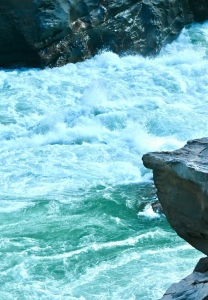
Lower Tiger Leaping Gorge
Lower Tiger Leaping Gorge is the least visited and most rugged section of the entire canyon. It’s a relatively undeveloped hiking route maintained by local villages. Because of its primitive condition, it’s best suited for experienced trekkers with prior high-altitude hiking experience. In this part of the gorge, the Jinsha River becomes calmer, and the intense turbulence seen upstream gradually eases. The dramatic cliffs give way to a more gentle and expansive landscape. The view opens up, revealing sprawling farmland and the river flowing freely through the valley. Here, you can witness the gentle, dancing curves of the Jinsha River and feel the exhilaration of water bursting through natural stone gates. The scenery also offers beautiful views of both Haba and Jade Dragon Snow Mountains.
- The hiking routes here are not well-established and are maintained solely by nearby villages. If this is your first time hiking in Tiger Leaping Gorge, it’s not recommended to start with the lower section.
- Similar to Middle Gorge, villagers may ask for a cleaning fee of around 10 CNY per person, which is commonly accepted by hikers.

Tiger Leaping Gorge Ticket Guide
Ticket Prices
- Adults: 45 CNY
- Children/Students: 22.5 CNY (valid for children aged 6 to 18 and university students or below)
- Seniors (60–70 years): 22.5 CNY
- Free Admission: Children under age 6 or under 1.2 meters in height, and seniors over 70 years old
Where to Buy Tickets
- Online: Book through third-party travel platforms
- Ticket Purchase: Trip.com Discounts
- Offline: You can purchase at the entrance, but lines are often long—booking online in advance is recommended.
Recommended Hiking Routes in Tiger Leaping Gorge
Tiger Leaping Gorge has official hiking routes and a printed trail map, and it is best to follow these rather than strike out on your own. The gorge—especially the Lower section—remains partly undeveloped, so safety cannot always be guaranteed. Furthermore, you may have heard that Middle Gorge is “closed.” In fact, only the Dazed Rock lookout is off-limits; the main hiking trail continues to operate normally.
Three Recommended Routes
- Route 1: (By bus from Lijiang or Shangri-La to) Qiaotou — Naxi Family GH — 28 Bends — Shanmei Guesthouse — Halfway — Tina’s — Sky Ladder — Teacher Zhang’s — Middle Tiger Leaping Gorge — Sky Gap — Walnut Garden — Lao Dukou — Daju (return to Lijiang or head on to Shangri-La)
- Tips: After Middle Gorge this route follows the Gorge Highway to Lower Gorge. If you have plenty of time and plan to visit Jade Dragon Snow Mountain, this is the ideal choice. Otherwise, skip it; Daju may charge an 80 CNY management fee plus the Jade Dragon ticket.
- Route 2: (By bus from Lijiang or Shangri-La to) Qiaotou — Naxi Family GH — 28 Bends — Shanmei Guesthouse — Halfway — Tina’s — Sky Gap / Sky Ladder / Teacher Zhang’s — Gorge Highway to Upper Tiger Leaping Gorge — Qiaotou (return to Lijiang or continue to Shangri-La)
- Route 3: (By bus from Lijiang or Shangri-La to) Qiaotou — Upper Tiger Leaping Gorge — Gorge Highway — Tina’s — Sky Gap / Sky Ladder / Teacher Zhang’s — Halfway — 28 Bends — Naxi Family GH — Qiaotou (return to Lijiang or continue to Shangri-La)
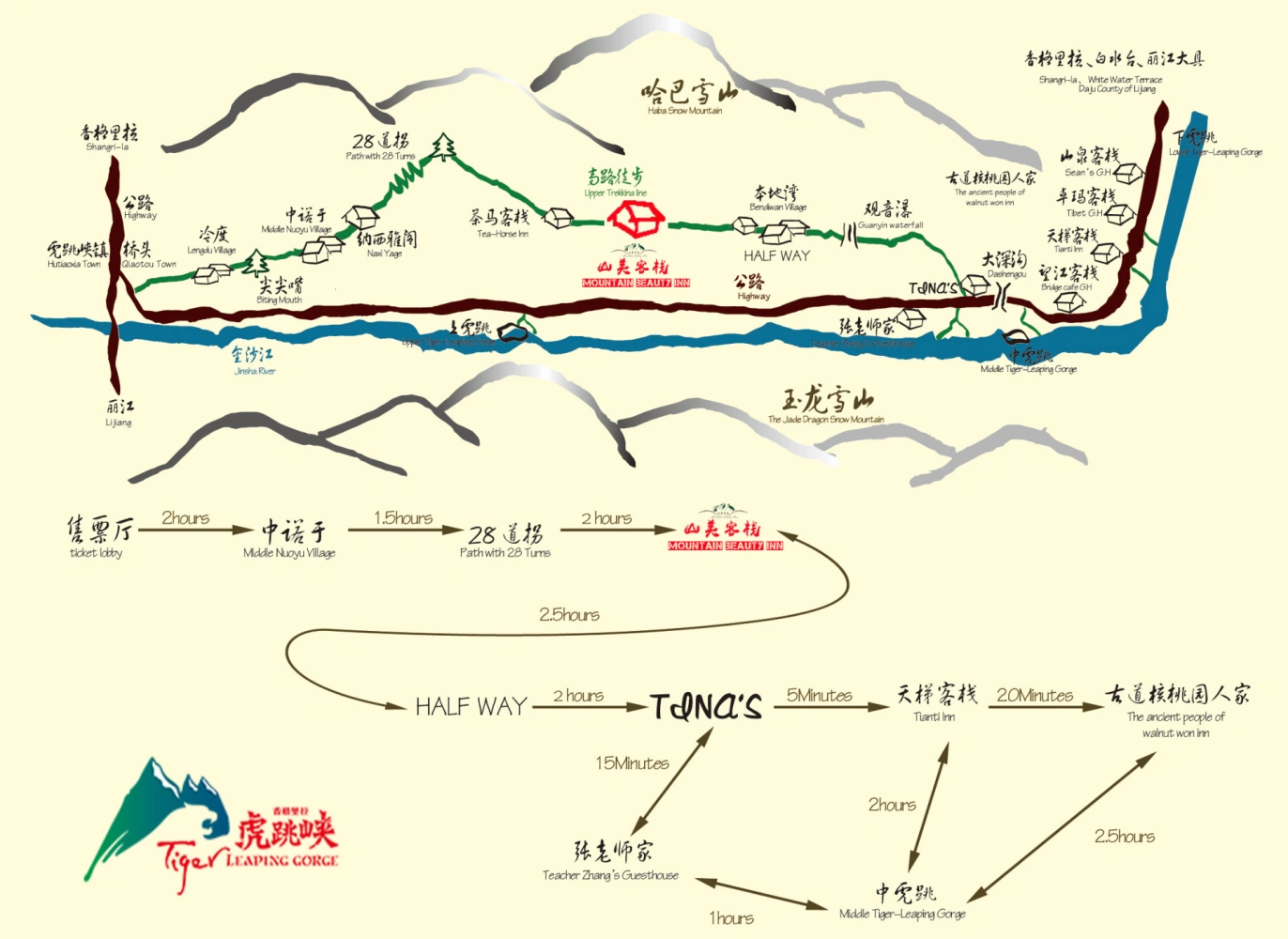
Recommended Itinerary
- Day 1: Lijiang (or Shangri-La) – Tiger Leaping Gorge (2 h) – Qiaotou (bag drop) – Naxi Family GH (2 h) – 28 Bends (Gan Yan Fang, ≈1.5 h) – Tea Horse GH (1.5 h) – Shanmei Guesthouse – Overnight at Halfway (3 h)
- Day 2: Halfway – Dragon Cave Waterfall (1.2 h) – Tina’s (1 h) – Middle Gorge (1.5 h) – Sky Gap – Sky Ladder – Teacher Zhang’s – Gorge Highway – Upper Gorge – Qiaotou (pick up bags) – Shangri-La (or Lijiang)
Transport
- Both the Shangri-La and Lijiang bus stations run coaches to Tiger Leaping Gorge (tell the driver you want to get off at Qiaotou). The fare is 40 CNY and the ride takes about two hours.
- When coaches stop running, hire a shared minivan. Split the cost with other travelers; the price is usually about 50 CNY per person.
- Around the bus stations many drivers solicit passengers. Ask several, then compare prices.
Pre-Hike Checklist
Essential gear: trekking poles (lifesavers on steep ground), two quick-dry shirts (they dry fast when you sweat or if the weather turns), a camera, plenty of high-calorie snacks, and only a small water supply; you can buy more along the trail at reasonable prices.
How to Get from Lijiang City to Tiger Leaping Gorge
Besides hiring a private car, the easiest option is the tourist coach from Lijiang to Shangri-La (98 CNY). The bus stops at Tiger Leaping Gorge for a two-hour visit en route.
- Official WeChat mini program: #小程序://丽交出行生活/EbTpw8UjvFsVpVA
- How to use: copy the link, send it to yourself in WeChat, and open the mini program from there.

Where to Store Luggage?
If you plan to return to Lijiang, the best place to leave bags is the Lijiang bus station; storage costs only 10 CNY maximum. Travelers heading onward to Xishuangbanna can leave luggage on the same long-distance bus during the Tiger Leaping Gorge stop—just confirm with the driver to avoid mishaps.
Recommended Places to Eat near Tiger Leaping Gorge
Halfway

- Reason to visit: Almost every trekking route passes this combined restaurant and guesthouse. Signature dishes include braised yak, “Hong San Duo” minced pork with chili, and deep-fried tea-tree mushrooms. The yak is tender and pairs perfectly with rice.
- Address: No. 50, Yongsheng Bendiwancun, Hutiaoxia Town, Shangri-La, Diqing Tibetan Prefecture (Apple Maps/Amap)
- Hours: Mon–Sun 08:00–20:00
- Average spend: 64 CNY
Qiya Cliff Café
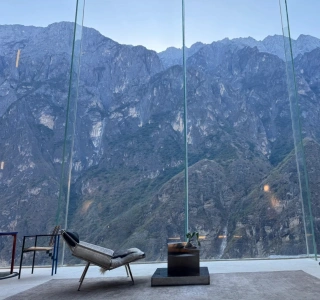
- Reason to visit: Located mid-gorge, its floor-to-ceiling windows make a superb photo spot. The coffee is excellent, so drop by if you pass.
- Address: No. 33, East Ring Road, Shangri-La, Diqing Tibetan Prefecture (Apple Maps/Amap)
- Hours: Mon–Sun 08:00–20:00
- Average spend: 56 CNY
Recommended Hotels near Tiger Leaping Gorge
Judy’s Guest House
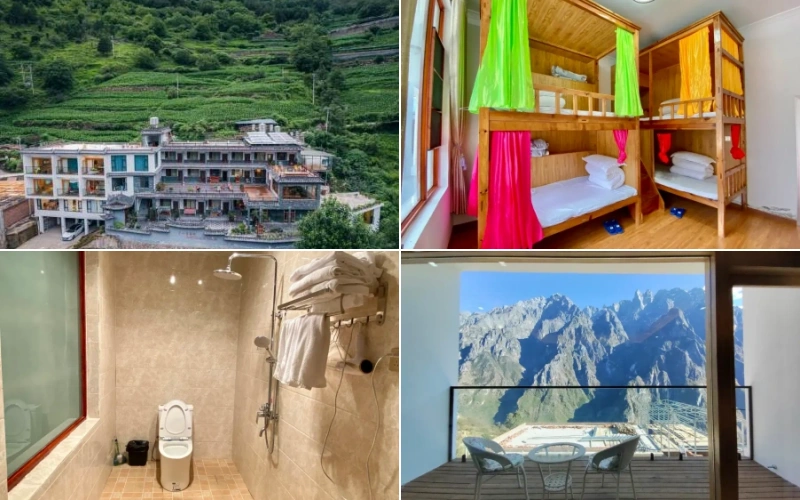
- Price per night: 268 CNY
- Check rates: Trip.com Specials
- Rating: Trip 9.3
The homestay sits close to Halfway, so the big terrace is always within reach for photos. The owner gives practical trekking advice. Facilities are simpler than in the city, yet a comfy base in the mountains.
Suggested “Half-Mountain” loop—take the bus from Lijiang in the morning to Tea Horse GH, hike two hours to Judy’s, rest two hours, hike round-trip to Dragon Cave Waterfall in about three hours (afternoon light hits the opposite cliffs beautifully), then explore photo spots the next morning before returning to Lijiang.
La Villa De LEE·MOYE of Lisu·Moye | Snow Mountain Cliff Hotel
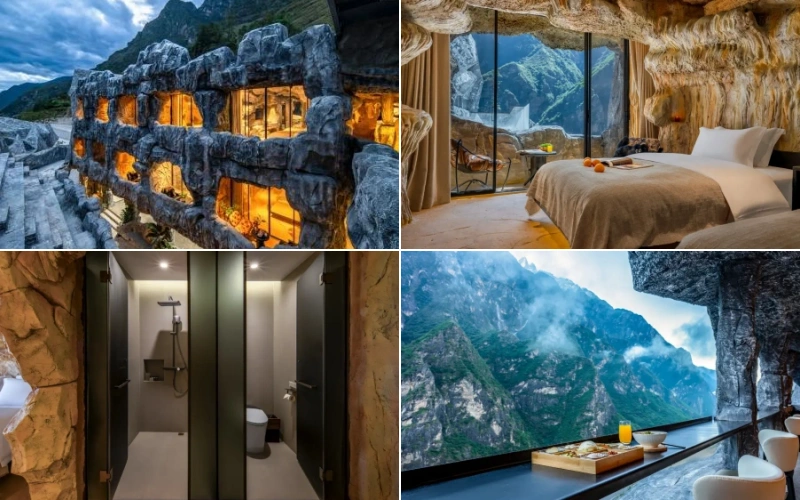
- Price per night: 1,632 CNY
- Check rates: Trip.com Specials
- Rating: Trip 9.5
One of the few upscale stays near Tiger Leaping Gorge. If you want to trek but also insist on high-end comfort, this hotel is a must. The cave-inspired design feels both primal and stylish, and the twin beds are supremely soft. Dining with a direct view of the gorge elevates every bite.
The hotel provides its own trail suggestions and even gifts a trekking kit at check-in—a thoughtful touch for serious hikers.

 English (US)
English (US)  English (Hong Kong)
English (Hong Kong)  English (Malaysia)
English (Malaysia)  English (Singapore)
English (Singapore)  繁體中文
繁體中文 
Comment (0)